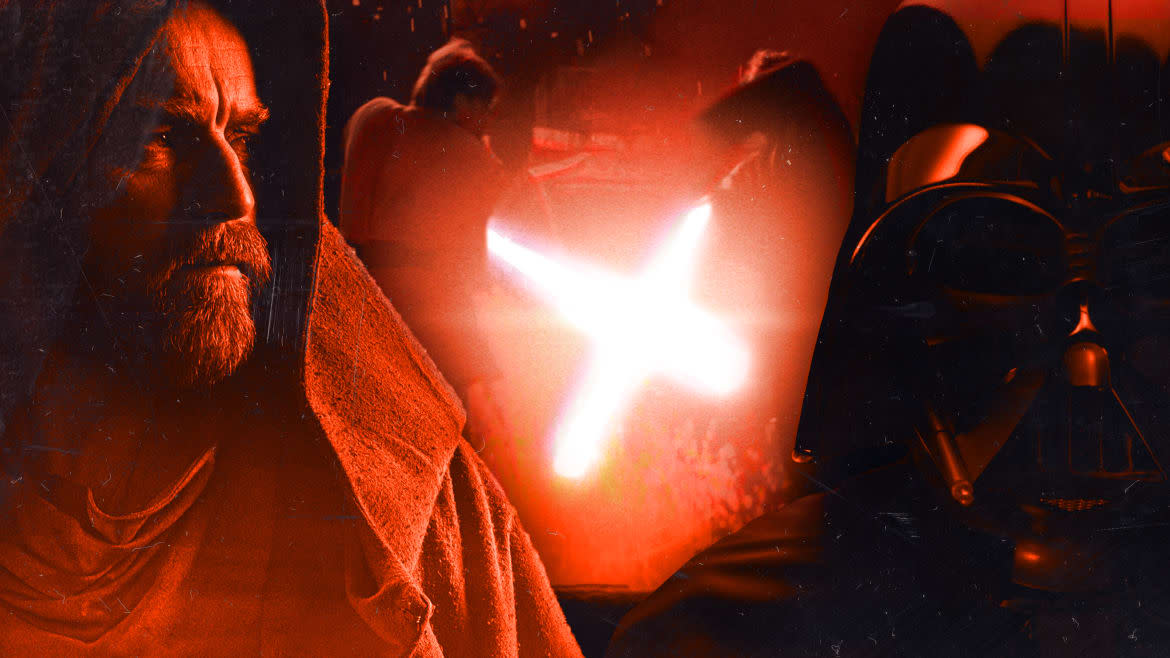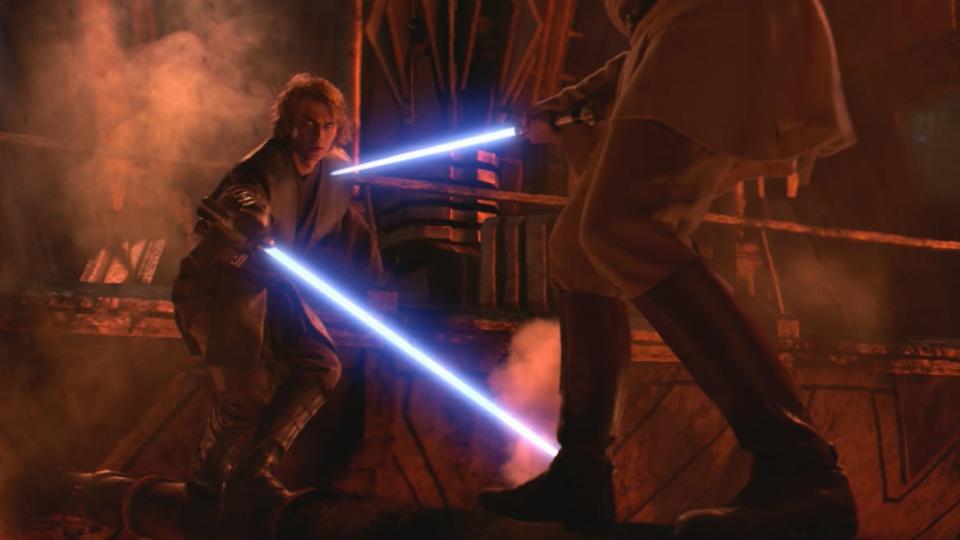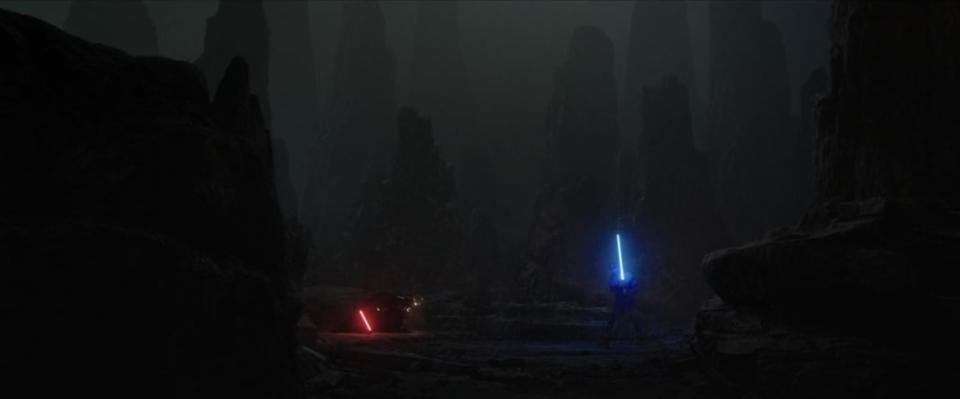‘Obi-Wan Kenobi’ Ends With a Battle We’ve Waited 17 Years For

The best part of the Obi-Wan Kenobi finale was one that felt very, very familiar: a fight that might as well have been an ode to the best battle in “Star Wars” history.
I’m talking about Obi-Wan Kenobi and Anakin Skywalker’s battle on the lava planet of Mustafar in Star Wars: Episode III — Revenge of the Sith. Unpopular opinion or not, the 17-year-old scene remains lightsaber dueling at its finest. It’s an epic, emotional duel: the culmination of the men’s evolution from master-and-apprentice to brothers to, finally, enemies, all while “Battle of the Heroes” vibrates in the background.
It’s not only one of the series’ most memorable and best-choreographed lightsaber battles, but it’s also one of its most recognizable. In recent years, the battle on Mustafar has birthed TikTok trends, merch, and memes galore. It’s only fitting, then, that the final episode of Obi-Wan Kenobi—which marks Obi-Wan and Anakin’s first reunion on-screen since Revenge of the Sith—has a battle recalling the pair’s most iconic one as its centerpiece.

Anakin Skywalker (Hayden Christensen, left) and Obi-Wan Kenobi (Ewan McGregor) square off in Star Wars: Episode III — Revenge of the Sith.
There are of course years, plot points, and many changes between the duel that led Anakin to fully transform into Darth Vader and his rematch with Obi-Wan. Even without referencing the other media bridging the gap between the final prequel and this series, Obi-Wan Kenobi does a decent job of depicting just how many vast changes occur in that time. In the series, it’s been a decade of Empire rule and Darth Vader is at his most feared self. He’s in charge of the Inquisitors and the effort to fully exterminate the Jedi and stamp out any hope others may have for their return.
As is the case with a lot of Star Wars lore nowadays, Obi-Wan Kenobi might be seen as nothing more than Disney and Lucasfilm trying to fill in the Skywalker saga’s gaps after the fact. So while fans know that Obi-Wan goes on to become the old hermit Ben by the start of Episode IV — A New Hope, the series took on the challenge of fleshing out how he got to that place. After surviving the Jedi Purge and reckoning with his guilt over once training the now-sadistic Darth Vader, Kenobi’s desire to squash out his Force abilities and his connection to it makes sense—as does showing the great Jedi Knight at his lowest.
Watching Obi-Wan cower and run from Darth Vader throughout Kenobi’s first half was admittedly tough to sit through, as someone who loves and roots for the character. He’s no less cunning and loyal, but he’s much less able to tap into the Force and the strength that it provides him. But Obi-Wan’s moments of weakness give weight to a powerful return to form in the long-awaited reunion between master and former padawan. (It was made all the more powerful thanks to the fact that Ewan McGregor and Hayden Christensen both returned to play Obi-Wan and Anakin, respectively.) And just like on Mustafar, this battle makes manifest the pair’s entire tortured history.
‘Obi-Wan Kenobi’ Redefines Padmé’s Entire Legacy in One Moment
The parallels between the heartbreaking, intense battle in Revenge of the Sith and this one in Obi-Wan Kenobi are clear, even on a surface level. For one, Vader arrives to the fight in Kenobi in a similar fashion as Obi-Wan does in Revenge of the Sith: walking off the ramp of his ship. And right before they start fighting, Obi-Wan repeats the exact same line he said to kick off the battle from Revenge of the Sith—the unforgettable “I will do what I must.”
But the differences between these fights are also profound. Whereas Anakin (freshly christened as Darth Vader) is frantic and almost foaming at the mouth in his anger on the lava planet, Vader is quietly menacing in Kenobi. This, of course, gives the scene a very different overall vibe, but the tonal shift also highlights the time lost and Vader’s maturity (for lack of a better word) at this point, 10 years since the events of Revenge of the Sith occurred.
For Obi-Wan, he may have even more to lose now than he did in the previous film—considering he just spent many days forming a strong bond with Leia. He knows he has to keep both twins hidden to safeguard the future of the Jedi and the galaxy, lest Darth Vader have his way with it. While he lost his best friend once before, losing the twins would be like losing him all over again.
But maybe the biggest difference between the two battles is the fighting itself. In Revenge of the Sith’s duel, it’s almost comical how in sync Obi-Wan and Anakin are. They hit each other, blow for blow, using identical moves. There’s even a moment where their lightsabers are just windmilling in front of each other, hitting only air instead of each other. Obi-Wan trained Anakin perfectly, as Qui-Gon Jinn (Liam Neeson, who makes a quick appearance in Kenobi as a Force Ghost) implored him to as he died. Despite Anakin’s many excess midi-chlorians or his inherent, raw power, he’s still the product of Kenobi’s training. Anakin just can’t win with his cockiness and desire to dominate against Kenobi’s years of skill and expertise.

Darth Vader, né Anakin, and Obi-Wan tussle in the Kenobi finale.
In Kenobi, Vader is purposeful and more experienced. Joining the Dark Side has only strengthened his anger and hatred, which in turn has greatened his powers. But by the time they meet for this duel, Kenobi has reconnected fully with the Force giving him back the strength that Anakin once craved.
As they fight, they are no longer echoing each other; they are more evenly matched than they ever were on the big screen. Vader even gets the high ground this time, nearly killing Obi-Wan under rubble. But Kenobi’s mission and desire to protect Leia and Luke win out and give him the push he needs to overtake Vader and end the fight.
Any good “Star Wars” fan knows that Vader’s weakness is his hate-fueled need for vengeance, not Kenobi’s devotion to the light side and all that’s good. But it’s still so moving when the scene’s final gut-punch—when Obi-Wan slashes through to Vader’s face—solidifies what this battle already meant: Anakin is truly dead and no longer an entity in Vader’s body or intentions.
Even though Obi-Wan’s transition at the episode’s end into Tatooine’s Friendly Neighborhood Ben Kenobi, the one we see in A New Hope, was slightly heavy-handed—especially his conversation with Bail Organa about what to do if they ever need Obi-Wan’s help again—it felt earned. And the battle that paid homage to such a climactic one from over a decade ago proves that this series did what it needed to do to get us to that moment. It succeeded in unspooling for fans, especially those of the prequels (yes, we exist!) the continued legend of Obi-Wan Kenobi by pulling in what he deems as his biggest failure: Anakin.
Get the Daily Beast's biggest scoops and scandals delivered right to your inbox. Sign up now.
Stay informed and gain unlimited access to the Daily Beast's unmatched reporting. Subscribe now.

 Yahoo News
Yahoo News 
